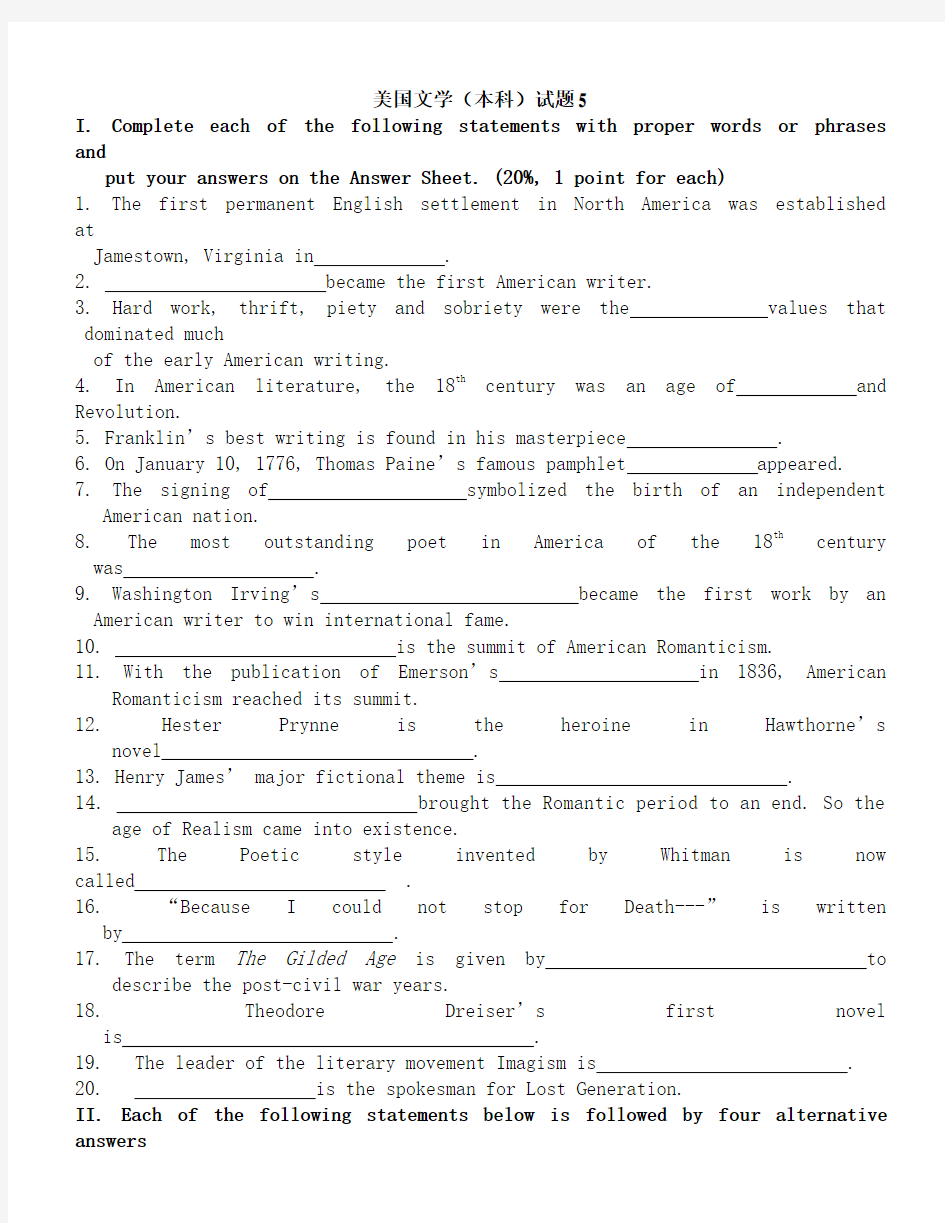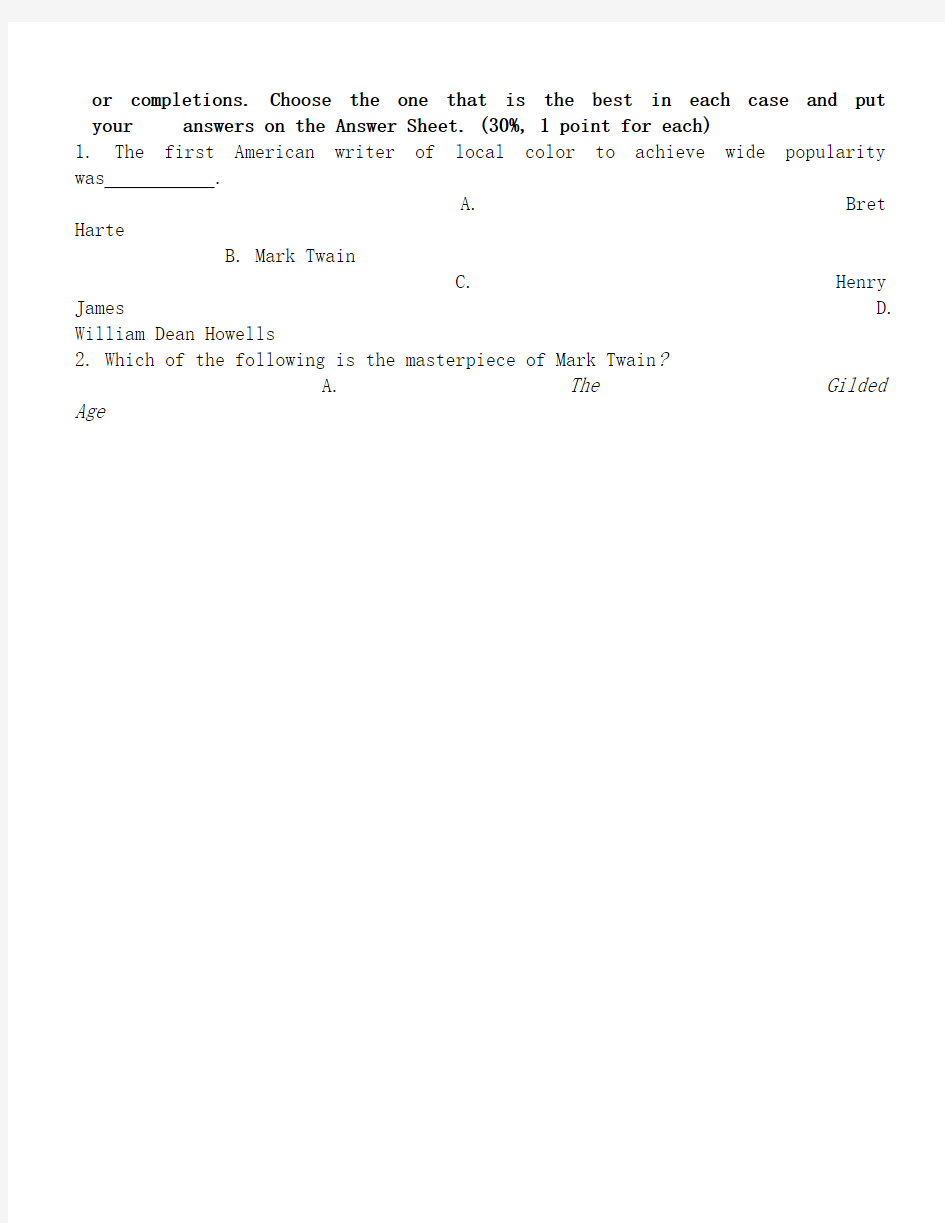美国文学试题


美国文学(本科)试题5
I. Complete each of the following statements with proper words or phrases and
put your answers on the Answer Sheet. (20%, 1 point for each)
1. The first permanent English settlement in North America was established at
Jamestown, Virginia in .
2. became the first American writer.
3. Hard work, thrift, piety and sobriety were the values that dominated much
of the early American writing.
4. In American literature, the 18th century was an age of and Revolution.
5. Franklin’s best writing is found in his masterpiece .
6. On January 10, 1776, Thomas Paine’s famous pamphlet appeared.
7. The signing of symbolized the birth of an independent
American nation.
8. The most outstanding poet in America of the 18th century was .
9. Washington Irving’s became the first work by an American writer to win international fame.
10. is the summit of American Romanticism.
11. With the publication of Emerson’s in 1836,American
Romanticism reached its summit.
12. Hester Prynne is the heroine in Hawthorne’s
novel .
13.Henry James’ major fictional theme is .
14. brought the Romantic period to an end. So the
age of Realism came into existence.
15. The Poetic style invented by Whitman is now called .
16. “Because I could not stop for Death---” is written
by .
17. The term The Gilded Age is given by to
describe the post-civil war years.
18. Theodore Dreiser’s first novel
is .
19. The leader of the literary movement Imagism is .
20. is the spokesman for Lost Generation.
II. Each of the following statements below is followed by four alternative answers
or completions. Choose the one that is the best in each case and put your answers on the Answer Sheet. (30%, 1 point for each)
1. The first American writer of local color to achieve wide popularity was .
A. Bret Harte
B. Mark Twain
C. Henry James
D. William Dean Howells
2. Which of the following is the masterpiece of Mark Twain?
A. The Gilded Age
B. The Adventures of Tom Sawyer
C. The Adventures of Huckleberry Finn
D. Jumping Frog
3. Which writer has no naturalist tendency?
A. Mark Twain
B. Jack London
C. Theodore Dreiser
D. Frank Norris
4. Transcendentalist doctrines found their greatest literary advocates in and
Thoreau.
A.
Jefferson
B. Emerson
C.
Freneau
D. Oversoul
5. Which of the following doesn’t belong to Dreiser’s “Trilogy of Desire”?
A. The Financier
B. The Titan
C. The Stoic
D. An American Tragedy
6. Which is the character who appears in the novel Moby Dick?
A. Hester Prynne
B. Mr. Hooper
C. Ahab
D. Pearl
7. written by Henry James brought him first international fame.
A. The Golden Bowl
B. The American
C. The Tragic Muse
D. Daisy Miller
8. “”was a term created by the French novelist, Emile Zola.
A.
realism
B. naturalism
C.
transcendentalism
D. veritism
9. Jack London was at his height of his powers when he wrote , which is deeply influenced by Darwinism.
A. The Sea Wolf
B. To Build a Fire
C. The Call of the Wild
D. Martin Eden
10. The Cop and the Anthem is written by .
A. O. Henry
B. Henry James
C. Jack London
D. Mark Twain
11. “Two small people, without dislike or suspicion.” is a line in the poem
The River-Merchant’s Wife: A Letter written by .
A. T. S. Eliot
B.Robert Frost
C.Ezra Pound
D. Carl Sandburg
12. The imagist poets followed three principles, they are , direct
treatment and economy of expression.
A. blank verse
B. rhythm
C. free verse
D. common speech
13. Of the following American writers, who has NOT been an expatriate in
Paris?
A. Ernest Hemingway
B. Ezra Pound
C. F. S. Fitzgerald
D. Emily Dickinson
14. Who was the foremost novelist of the American Depression of the 1930s?
A. Ernest Hemingway
B. Ezra Pound
C. John Steinbeck
D.
F. S. Fitzgerald
15. The first writings that we call American were the narratives and of
the early settlements.
A. journals
B. poetry
C. drama
D. folklores
16. An American Dictionary of the English Language was published in 1828
by .
A. Samuel Johnson
B. Noah Webster
C. Daniel Webster
D. Daniel Defoe
17. Walden is written by .
A. Emerson
B. Thoreau
C. Poe
D. Hawthorne
18. is famous for psychological realism.
A. Mark Twain
B. William Dean Howells
C. Henry James
D. Walt Whitman
19. Which is generally regarded as the Bible of New England Transcendentalism?
A. Nature
B. Walden
C. On Beauty
D. Self-Reliance
20. Which is regarded as the “Declaration of Intellectual Independence”?
A. The American Scholar
B. English Traits
C. The Conduct of Life
D. Nature
21. Santiago is the character in Hemingway’s novel .
A. In Our Time
B. The Old Man and the Sea
C. For Whom the Bell Tolls
D.The Sun Also Rises
22. Which of the following is a much harsher realism?
A. local colorism
B. naturalism
C. romanticism
D. imagism
23. Who is the arbiter of 19th century literary realism in America?
A. Mark Twain
B. Bret Harte
C. William Dean Howells
D. Henry James
24. F. S. Fitzgerald is NOT the author of .
A. The Great Gatsby
B.Tender is the Night
C. A Farewell to the Arms
D. This Side of Paradise
25. The pessimism and deterministic ideas of naturalism pervaded the works of
such American writers as .
A. Mark Twain
B. F. S. Fitzgerald
C. Walt Whitman
D. Stephen Crane
26. Charles Drouet is a character in the novel of______.
A. The American
B. The Portrait of a Lady
C. Sister Carrie
D. The Gift of the Magi
27. American literature produced only one female poet during the 19th century.
She was .
A. Anne Bradstreet
B. Jane Austen
C. Emily Dickinson
D. Harriet Beecher
28. read his poetry at the inauguration of President John F. Kennedy.
A. Robert Frost
B. T. S. Eliot
C. Carl Sandburg
D. Ezra Pound
29. With Howells, James and Mark Twain active on the scene, became
the major trend in the 70s and 80s of the 19th century.
A. sentimentalism
B. romanticism
C.
realism
D. naturalism
30. “The apparition of these faces in the crowd; Petals on a wet, black
bough”. This is the shortest poem written by .
A. T. S. Eliot
B. Robert Frost
C.Ezra Pound
D. Wallace Stevens
III. Comment on the following poems. Put your answers on the Answer Sheet. (20%,
10 points for each)
1.Stopping by Woods on a Snowy Evening
by: Robert Frost
Whose woods these are I think I know.
His house is in the village though;
He will not see me stopping here
To watch his woods fill up with snow.
My little horse must think it queer
To stop without a farmhouse near
Between the woods and frozen lake
The darkest evening of the year.
He gives his harness bells a shake
To ask if there is some mistake.
The only other sound’s the sweep
Of easy wind and downy flake.
The woods are lovely, dark and deep.
But I have promises to keep,
And miles to go before I sleep,
And miles to go before I sleep.
1. I Heard a Fly Buzz—When I Died—
by: Emily Dickinson
I heard a Fly buzz —when I died —The Stillness in the Room
Was like the Stillness in the Air —
Between the Heaves of Storm —
The Eyes around — had wrung them dry —
And Breaths were gathering firm
For that last Onset —when the King Be witnessed —in the Room —
I willed my Keepsakes —Signed away What portion of me be
Assignable —and then it was There interposed a Fly —
With Blue —uncertain stumbling Buzz —Between the light —and me —And then the Windows failed — and then
I could not see to see —
IV. Give brief answers to the following and write your answers on the Answer Sheet. (30%, 15 points for each)
1. Being a period of the great flowering of American literature, the Romantic Period is called “the American Renaissance”. Briefly discuss what the features of American literature in this period are.
2. How does Sister Carrie embody Dreiser’
I. Complete each of the following statements with proper words or phrases and
put your answers on the Answer Sheet. (20%, 1 point for each)
1. 1607
2. John Smith
3. Puritan
4. Reason
5. The Autobiography
6. Common Sense
7. The Declaration of Independence
8. Philip Freneau 9. Sketch Book 10. Transcendentalism
11. Nature 12. The Scarlet Letter 13. international theme 14. The civil war
15. free verse 16. Emily Dickinson 17. Mark Twain
18.Sister Carrie 19. Ezra Pound20. Ernest Hemingway
II. Each of the following statements below is followed by four alternative answers or completions. Choose the one that is the best in each case and put your answers on the Answer Sheet. (30%, 1 point for each)
1 --- 5: A C A B D 6 --- 10: C D B C A
11 ---15:C B D C A 16 --- 20: B B C A A
21 ---25: B B C C D 26 --- 30: C C A C C
III. Comment on the following poems. Put your answers on the Answer Sheet. (20%,
10 points for each)
1. "Stopping by Woods on a Snowy Evening" was Frost's favorite of his own poems and Frost in a letter to Louis Untermeyer called it "my best bid for remembrance."
This poem illustrates many of the qualities most characteristic of Frost, including the attention to natural detail, the relationship between humans and nature, and the strong theme suggested by individual lines. The speaker in the poem, a traveler by horse on the darkest night of the year, stops to watch a woods filling up with snow. He thinks the owner of the woods is someone who lives in the village and will not see him stopping there. While he is attracted by the beauty of the woods and nature, he is reminded by his little horse and realizes that he has obligations which pull him away from the lure of nature. The speaker describes th e beauty and temptation of the woods as “lovely, dark and deep,” but reminds himself that he must not remain there, because he has “promises to keep,” and a long journey ahead of him. He has to complete his obligations and then make his aspirations to be realized. Through the symbolic woods and horse, we also get to know that the speaker has strong self-awareness and self-discipline.
In another way, the poem can be analyzed from the perspective of aspiration and realization. Aspiration is something to be worked at. We enjoy the fruit of our realization only when we reach our destination. But from the spiritual point of view, we notice something else that is the transformation of aspiration and realization. Today's aspiration transforms itself into tomorrow's realization. Again, tomorrow's realization is the pathfinder of a higher and deeper goal. There is no end to our realization, and there is no end of our aspiration as long as you are alive. Our journey is eternal, and the road that we are taking on is al so eternal. All aspirations become realization till the end of one’s life.
